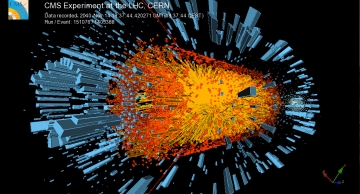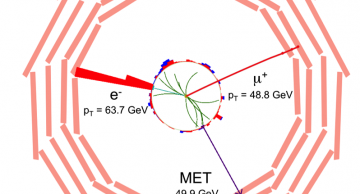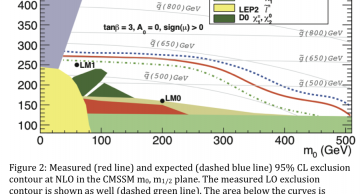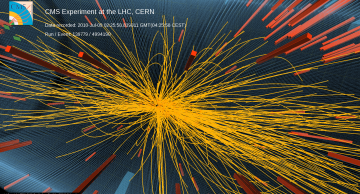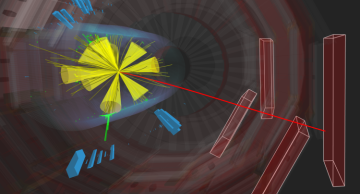In our Universe today, quarks are always bound together by gluons to form "composite" particles such as protons and neutrons. The Quark-Gluon Plasma, or QGP, often described as a soup-like medium, is a hot, dense state in which these quarks and…
News
|
achintya |
Physics
|
achintya |
Physics
The CMS experiment has made several unique measurements using data from LHC collisions of lead nuclei (PbPb, November 2010) at centre-of-mass energies of 2.76 TeV per nucleon pair.
Phenomena measured for the first time in nucleus-nucleus collisions…
|
lucas |
Physics
The CMS Collaboration at CERN released a paper today entitled "First Measurement of W+W− Production and Search for Higgs Boson in pp Collisions at √s = 7 TeV". The paper is the first produced by CMS that includes searches for the Higgs boson at the…
|
lucas |
Physics
The Compact Muon Solenoid (CMS) Collaboration at CERN’s Large Hadron Collider (LHC) has announced the results of the search for supersymmetry (SUSY) in events with jets and missing transverse energy. The search is based on data accumulated by the…
|
achintya |
Physics
The CMS experiment at CERN's Large Hadron Collider (LHC) has completed a search for microscopic black holes produced in high-energy proton-proton collisions. No evidence for their production was found and their production has been excluded up to a…
|
achintya |
Physics
After only three weeks of heavy-ion running at CERN’s Large Hadron Collider (LHC), the CMS experiment is already yielding new insights into the condition of matter that existed in the very first instants of the Universe’s life, some 13.7 billion…
|
achintya |
Physics
The CMS experiment at CERN's Large Hadron Collider (LHC) has recorded its first Lead-Lead collisions at a centre-of-mass energy of 2.76 TeV per nucleon pair, marking the start of its heavy ion research programme. Physicists around the world expect a…
|
achintya |
Physics
Z bosons produced in collisions of heavy ions have been observed for the first time by the CMS experiment at CERN’s Large Hadron Collider (LHC). CMS observed 10 events containing a distinctive candidate Z boson reconstructed from a pair of electrons…
|
achintya |
Physics
The CMS Collaboration at CERN released today a paper entitled "Observation of Long-Range Near-Side Angular Correlations in Proton-Proton Collisions" that details signs of a new phenomenon in proton interactions.
A study of "high multiplicity"…
|
achintya |
Physics
For the past four months the LHC has been ramping-up the intensity of the beams, creating billions of 7 TeV proton-proton collisions. This has enabled CMS to study a variety of known physics from the Standard Model, including the "re-discovery" of…
|
achintya |
Physics
The first 7 TeV (3.5 TeV + 3.5 TeV) collisions took place on 30th March 2010, starting around 1pm local (Geneva) time and lasting for about 3.5 hours. Read the CERN Press Release here.
The CMS detector and its collaborators are all eagerly awaiting…
|
ajafari |
Physics
Supersymmetry, or SUSY in short, is an exciting and beautiful theory that answers some of the open questions in particle physics, predicting that all known particles have a partner (a superpartner!) with somewhat different properties. For example,…

